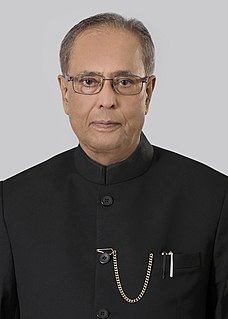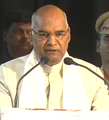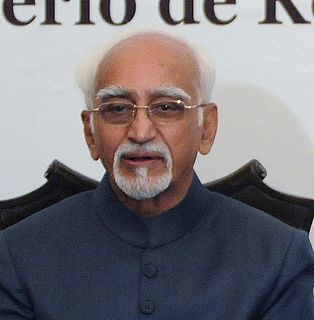| |||||||||||||||||||||||
| Turnout | 99% (estimated) [1] | ||||||||||||||||||||||
| |||||||||||||||||||||||
| |||||||||||||||||||||||
A presidential election was held in India on 17 July 2017 with the votes counted and the results announced on 20 July 2017. Ram Nath Kovind became 14th President of India. President Pranab Mukherjee, whose term of office was due to expire on 24 July 2017, [2] declined to seek re-election due to health concerns.

The President of India is the ceremonial head of state of India and the commander-in-chief of the Indian Armed Forces.

Pranab Mukherjee is an Indian politician who served as the 13th President of India from 2012 until 2017. He is a Bharat Ratna awardee, awarded in 2019 by President of India Shri Ram Nath Kovind. In a political career spanning five decades, Mukherjee has been a senior leader in the Indian National Congress and has occupied several ministerial portfolios in the Government of India. Prior to his election as President, Mukherjee was Union Finance Minister from 2009 to 2012.
Contents
- Background
- Selection process
- Electoral college partisan composition
- Public opinion
- Candidates
- Bharatiya Janata Party
- Indian National Congress
- Results
- Reactions
- See also
- References
- External links
Governor of Bihar Ram Nath Kovind of the Bharatiya Janata Party had the backing of the governing National Democratic Alliance coalition, and went up against opposition candidate Meira Kumar of the Indian National Congress in the vote. Kovind secured roughly two thirds of the votes from the electoral college of elected members of federal, state and union territory legislatures and was elected to a five-year term as President. [3] Kovind's term of office began on 25 July 2017.

Ram Nath Kovind is an Indian politician currently serving as the 14th President of India, in office since 25 July 2017. Previously he had served as the Governor of Bihar from 2015 to 2017 and was a Member of Parliament, Rajya Sabha from 1994 to 2006. Kovind was nominated as a presidential candidate by the ruling NDA coalition and won the 2017 presidential election.

The Bharatiya Janata Party is one of the two major political parties in India, along with the Indian National Congress. As of 2018, it is the country's largest political party in terms of representation in the national parliament and state assemblies, and it is the world's largest party in terms of primary membership. BJP is a right-wing party, and its policy has historically reflected Hindu nationalist positions. It has close ideological and organisational links to the Rashtriya Swayamsevak Sangh (RSS).
The National Democratic Alliance (NDA) is a coalition of Progressive centre-right to right-wing political parties in India. At the time of its formation in 1998, it was led by the Bharatiya Janata Party (BJP) and had 13 constituent parties. Its chairman was late Prime Minister Atal Bihari Vajpayee. Also representing the alliance are L. K. Advani, former Deputy Prime Minister, who is the acting chairman of the Alliance, Narendra Modi, current Prime Minister and the Leader of the House in Lok Sabha; and Arun Jaitley, Leader of the House in Rajya Sabha and Finance minister. The coalition ruled from 1998 to 2004. The alliance returned to power in the 2014 General election with a combined vote share of 38.5%. Its leader, Narendra Modi, was sworn in as Prime Minister of India on 26 May 2014.





















